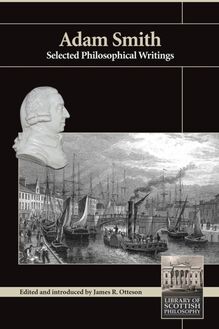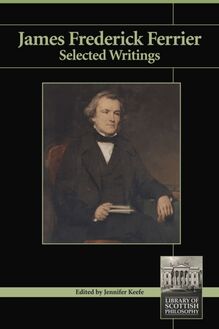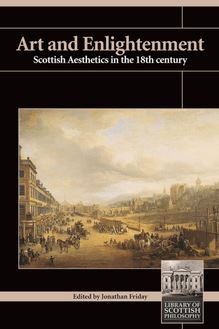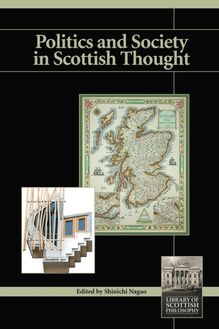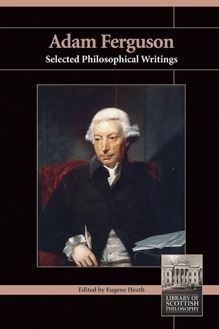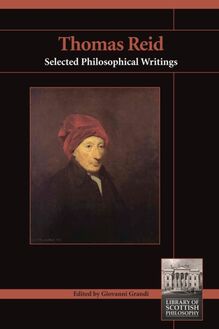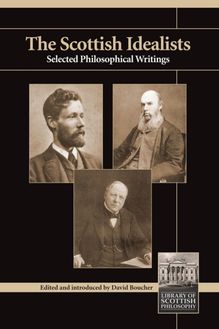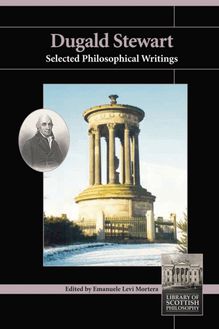Thomas Brown , livre ebook
115
pages
English
Ebooks
2012
Vous pourrez modifier la taille du texte de cet ouvrage
Obtenez un accès à la bibliothèque pour le consulter en ligne En savoir plus
Découvre YouScribe en t'inscrivant gratuitement
Découvre YouScribe en t'inscrivant gratuitement
115
pages
English
Ebooks
2012
Vous pourrez modifier la taille du texte de cet ouvrage
Obtenez un accès à la bibliothèque pour le consulter en ligne En savoir plus
Publié par
Date de parution
09 octobre 2012
Nombre de lectures
3
EAN13
9781845404345
Langue
English
Publié par
Date de parution
09 octobre 2012
Nombre de lectures
3
EAN13
9781845404345
Langue
English
Title page
Thomas Brown
Selected Philosophical Writings
Edited and Introduced
by Thomas Dixon
Copyright page
Copyright © Thomas Dixon, 2010
The moral rights of the author have been asserted
No part of any contribution may be reproduced in any form without permission, except for the quotation of brief passages in criticism and discussion.
Originally published in the UK by Imprint Academic
PO Box 200, Exeter EX5 5YX, UK
Originally published in the USA by Imprint Academic
Philosophy Documentation Center
PO Box 7147, Charlottesville, VA 22906-7147, USA
2012 digital version by Andrews UK Limited
www.andrewsuk.com
Full series details:
www.imprint-academic.com/losp
Series Editor’s Note
The principal purpose of volumes in this series is not to provide scholars with accurate editions, but to make the writings of Scottish philosophers accessible to a new generation of modern readers in an attractively produced and competitively priced format. In accordance with this purpose, certain changes have been made to the original texts: Spelling and punctuation have been modernized. In some cases, the selected passages have been given new titles. Some original footnotes and references have not been included. Some extracts have been shortened from their original length. Quotations from Greek have been transliterated, and passages in foreign languages translated, or omitted altogether.
Care has been taken to ensure that in no instance do these amendments truncate the argument or alter the meaning intended by the original author. For readers who want to consult the original texts, full bibliographical details are provided for each extract.
The Library of Scottish Philosophy was originally an initiative of the Centre for the Study of Scottish Philosophy at the University of Aberdeen and the first six volumes were commissioned with financial support from the Carnegie Trust for the Universities of Scotland. In 2006 the CSSP became one of three research centers within the Special Collections of Princeton Theological Seminary, and subsequent volumes have received financial support from the Seminary. The selections in this volume were prepared for publication by Mr James Foster, Editorial Assistant to the CSSP at Princeton.
Acknowledgements
The CSSP gratefully acknowledges the financial support of the Carnegie Trust and Princeton Seminary, the enthusiasm and excellent service of the publisher Imprint Academic, and the permission of the University of Aberdeen Special Collections and Libraries to use the engraving of the Faculty of Advocates (1829) as the logo for the series.
Gordon Graham,
Princeton, May 2010
I: Introduction
Thomas Brown’s Place in Nineteenth-Century Philosophy
Thomas Brown was one of the most influential and widely read British philosophers of the first half of the nineteenth century. As Professor of Moral Philosophy in Edinburgh from 1810 until his early death in 1820, Brown delivered a series of lectures on the philosophy of the human mind which, in their published form, went through numerous editions, winning him a reputation for metaphysical brilliance on both sides of the Atlantic. His thought provided a bridge between the Scottish school of “Common Sense” associated with Thomas Reid, and the later positivism of John Stuart Mill and others. [1] Brown shared with his Common Sense predecessors the view that certain beliefs, such as the belief in an external world and in causation, were primary and irresistible intuitions. In other ways, however, Brown’s thought had more in common with eighteenth-century sceptics and empiricists, including such figures as David Hume and Etienne de Condillac. As James Mackintosh put it, much of Brown’s philosophy constituted “an open revolt against the authority of Reid.” [2] Writing in 1900, Leslie Stephen suggested that Brown was “the last in the genuine line of Scottish common-sense philosophers” and that his thought illustrated the gravitation of that school towards “pure empiricism.” [3]
Thomas Brown made significant contributions to several areas of philosophy. In the philosophy of perception he emphasised the importance of the “muscle sense” in bringing about beliefs in external objects. In the philosophy of the human mind, Brown rejected the traditional faculty psychology, which posited such entities as the will and the intellect, and reduced all mental phenomena instead to a series of associated “states” or “affections.” These he divided into three categories: sensations, thoughts, and emotions. His was one of the first and most sustained treatments of the “emotions” as a coherent psychological category, which would come to subsume and supersede established categories such as the “passions,” “affections,” or “active powers” of the mind. [4] In the philosophy of science, Brown was rigorously phenomenalist, rejecting all metaphysical entities, whether subtle fluids, mental faculties, or causal powers. His Inquiry into the Relation of Cause and Effect (1818) provided a perceptive and influential commentary on the views of David Hume, and also gave the first unambiguous defence of what has become known as the “uniformity” or “regularity” view of causation. [5] Although many expressed concerns over Brown’s apparent lack of Christian orthodoxy, and over his reduction of moral judgements to the experience of a particular kind of emotions, his Lectures and his Inquiry both included reasoned arguments in favour of theistic belief.
Brown’s reputation was at its height during the two decades after the posthumous publication of his Lectures in 1820. These were widely acknowledged to be the most successful and popular work of their kind ever to have appeared. Henry Cockburn described the book as one of the most “delightful books in the English language,” which had enjoyed “unexampled success.” [6] The historian of Scottish Common Sense philosophy, James McCosh, painted a vivid picture of the impact of Brown’s lectures:
A course so eminently popular among students had not, I rather think, been delivered in any previous age in the University of Edinburgh, and has not, in a later age, been surpassed... In the last age you would have met, in Edinburgh and all over Scotland, with ministers and lawyers who fell into raptures when they spoke of his lectures.
The published version of the lectures enjoyed “a popularity in the British dominions and in the United States greater than any philosophical work ever enjoyed before.” “The writer of this article,” McCosh added, “would give much to have revived within him the enthusiasm which he felt when he first read them.” [7] Writing at the end of the nineteenth century, the British philosopher Robert Adamson wrote of the Lectures : “It is no exaggeration to say that never before or since has a work on metaphysics been so popular.” [8]
Several former Edinburgh students later wrote about the experience of hearing Thomas Brown lecture in person. The historian and philosopher J. D. Morell recalled:
The style was so captivating, the views so comprehensive, the arguments so acute, the whole thing so complete, that I was almost insensibly borne along upon the stream of his reasoning and eloquence. Naturally enough I became a zealous disciple; I accepted his mental analysis as almost perfect; I defended his doctrine of causation; with him I stood in astonishment at the alleged obtuseness of Reid. [9]
Sir Walter Scott’s son-in-law John Gibson Lockhart included an account of a lecture by Brown in his fictionalised portrait of Edinburgh society, Peter’s Letters to his Kinsfolk (1819). The students in the lecture room awaiting Brown’s appearance, in Lockhart’s version of the scene, include “a Pyrrhonist from Inverness-shire” alongside an “embryo clergyman” hoping for enlightenment about cause and effect and “feeling rather qualmish after having read that morning Hume’s Sceptical Solution of Sceptical Doubts.” Nearer the professor’s table sits “a crack member of some crack debating-club.” At last the dandyish Professor himself arrives “with a pleasant smile upon his face, arrayed in a black Geneva cloak, over a snuff-coloured coat and a buff waistcoat” with a “physiognomy very expressive of mildness and quiet contemplativeness.” Brown’s elocution is “distinct and elegant” and his metaphysics enlivened by quotations from the poets. [10]
Brown’s fastidious manner and poetical style were not, however, to everyone’s taste, and the positive appraisals of his work could seem embarrassingly overdone. The poet Edwin Atherstone’s exuberant praise of Brown in 1831 was a case in point. “For myself,” Atherstone wrote, “I know not a writer, with the exception of Shakespeare, Milton, Homer, and Scott, from whom I have derived such high delight as from Dr Brown.” [11] This was too much for one reviewer. “Was ever such a category put on paper before?” he asked. “It is as if a man should say his favourite musical instruments were the organ, the harp, the trumpet, the violin, and the sewing-machine.” [12] Thomas Carlyle might have agreed, recalling Brown as “an eloquent acute little gentleman, full of enthusiasm about simple suggestions, relative, etc.” which he found utterly dry and uninteresting. [13] Carlyle described the “immaculate Dr Brown” as “a really pure, high, if rather shrill and wire-drawing kind of a man”; and is reported to have referred to him as “Miss Brown” and “that little man who spouted poetry.” [14] Another contemporary commentator, Mrs Anne Macvicar Grant, wrote from Edinburgh to a friend in Glasgow of Brown’s “great fertility of mind” and “delightful variety of intelligence and playfulness in conversation, which, in the long run, conquers the prejudice resulting from a manner so affected and
